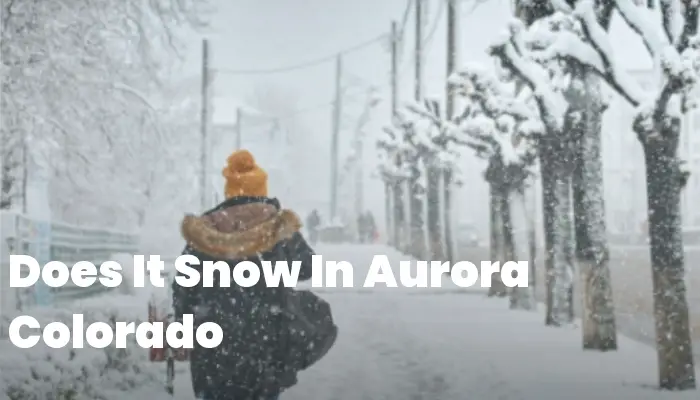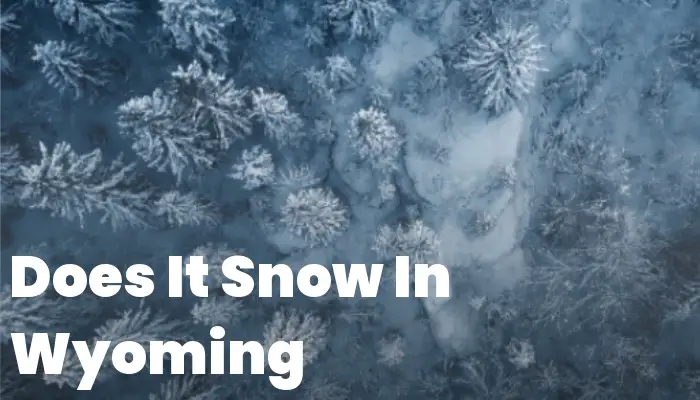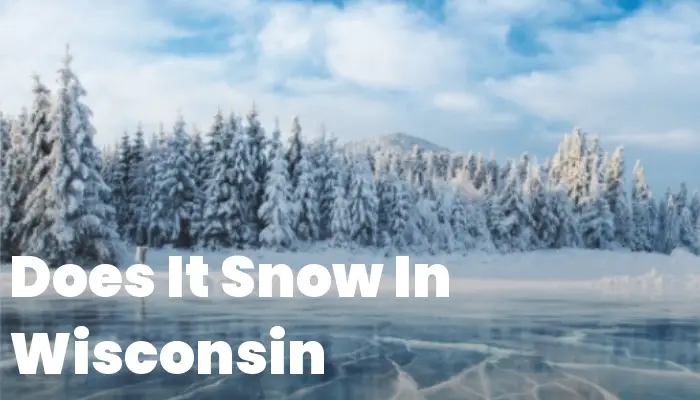Curious about the weather patterns in the Centennial State? Specifically, does it snow in Aurora, Colorado? Get ready to dive into an enlightening exploration of Aurora’s yearly climate, understanding how much snow this city receives, and when can you expect its arrival. In this article, we’ll tackle everything you need to know about the fascinating snowy season in Aurora, Colorado.
From average snowfall statistics to timelines showcasing when those beautiful flakes usually start falling from the sky – we have it all. Gain insights that will satisfy your curiosity or aid your trip planning efforts with our detailed discussion around Aurora’s winter wonderland.
Does It Snow In Aurora, Colorado?
If you’re pondering whether the city of Aurora experiences the wintery charm of snowfall, the answer is a resounding yes. Nestled just east of Denver, Aurora shares a similar climate to its metropolitan neighbor and becomes a picturesque landscape under a blanket of snow during the colder months. The city experiences all four seasons distinctly, with winter bringing in cooler temperatures that are conducive to snow.
The arrival of snow in Aurora can vary from year to year. Typically, though, residents can expect to see the first dustings as early as October and as late as April. This means if you’re planning on enjoying a snowy vista or engaging in winter sports, this timeframe is when you’d be looking at visiting.
When Does Snow Typically Begin and End?
In terms of specifics, historical weather patterns suggest that snowfall begins in earnest by late October or November. However, it’s not uncommon for light flurries to occur even earlier. On the tail end of the season, significant snow can fall well into April before tapering off as temperatures rise into spring. Although these timeframes provide a general guide, they are subject to change due to variances in annual weather patterns influenced by larger climatic events such as El Niño or La Niña.
How Much Does It Snow In Aurora Colorado?
Moving on from simply confirming that it does indeed snow in Aurora, let’s delve into how much powder you might expect when those clouds roll over the Rockies and cloak the city in white.
Average Annual Snowfall
Aurora sees an average annual snowfall that sits around 45 inches. This figure positions it slightly above many other U.S. cities but still below some of its higher altitude neighbors within Colorado itself. For comparison’s sake, this is somewhat more than what Denver receives annually given its proximity and similar elevation.
Snowiest Months
The bulk of Aurora’s accumulation typically happens during February and March—often regarded as Colorado’s heaviest-hitting months for snowfall due to increased moisture availability and persistent cold temperatures which aid in regular precipitation over short periods.
Peak Accumulation Periods:
- In February one could expect an average accumulation hovering around 8 inches,
- Moving into March you may see slightly higher averages close to 9 inches depending on prevailing conditions that year,
Variability Between Years
We must also highlight that these numbers come with their share of variability; certain years may yield significantly more or less than others based on broader climate trends or particular weather systems affecting the region during winter months.
Are There Ice Storms In Aurora Colorado?
Beyond fluffy flakes gently descending upon rooftops and pine trees lies another facet of winter – ice storms; notorious for their ability both mesmerize with their glistening sheen and disrupt through their treacherous nature.
Frequency Of Ice Storms
Luckily for residents and visitors alike,Aurora doesn’t frequently experience severe ice storms. It’s far enough inland from any large bodies of water which often contribute to ice storm conditions through lake-effect precipitation combined with freezing temperatures. However…
- This isn’t to say they don’t occur—they do—but often not with severity found elsewhere,
Icy conditions will more commonly manifest following lighter rainfalls transitioning into freezing temperatures overnight causing slippery roads and walkways rather than full-blown ice storms known elsewhere where inch-thick ice coats everything within reach after prolonged period rains amidst sub-zero temperatures.
Coping With Icy Conditions
When icy patches do appear throughout city – particularly bridges overpasses which tend freeze quicker than other surfaces due being exposed cold air from below well above – local authorities quick respond applying salt sand mixtures help mitigate risk accidents related slipping skating vehicles pedestrians alike.
Residents are advised stay tuned local weather forecasts winter approach ensuring preparedness should travel become hazardous result unexpected icy conditions making necessary adjustments routines schedules accommodate potentially slower pace life temporarily disrupts calm blanketed scene typical postcard-worthy Rocky Mountain winters.
Aurora, Colorado, nestled within the state’s diverse climatic regions, experiences its fair share of winter’s touch. Snowfall is a common occurrence in this bustling city just outside Denver. The question “Does It Snow In Colorado” can be confidently answered with a resounding yes when it comes to Aurora. With a climate that harbors cold winters, Aurora residents and visitors often witness the city draped in white during the snowy months. This weather pattern is characteristic of Colorado’s ability to offer a winter wonderland experience within many of its cities, including Aurora.
Where Does It Snow In Aurora, Colorado?
Snow in Aurora isn’t just confined to one specific area; the entire city gets its fair share of the white stuff. However, there can be slight variations in snowfall amounts depending on where you are in the city. This is due to factors like elevation and proximity to open spaces which can affect how snow accumulates.
Variation Across the City
In regions with higher elevations around Aurora, such as areas closer to the Black Forest region on the city’s outskirts, snow tends to be a bit more plentiful than in lower-lying neighborhoods. Parks and golf courses within the city may also experience higher accumulations due to their expansive open spaces that are less affected by urban heat islands.
Urban vs Suburban: Generally, downtown Aurora will see slightly less accumulation due to increased heat from buildings and infrastructure compared to more suburban or undeveloped areas.
Aurora Colorado Roads and Winter Weather Conditions
Winter weather conditions can greatly impact transportation within any city, and Aurora is no exception. Knowing how roads are maintained during snowy months is essential for safe travel.
Road Maintenance During Snow
- The City of Aurora has snow removal policies and procedures designed to keep major roadways clear.
- Priority is typically given to plowing main thoroughfares, emergency routes, and access points for public transit before residential streets.
- Aurora’s Public Works Department closely monitors storms so they can deploy crews efficiently when needed.
Citizens should be aware that during heavy snowfall events even primary roads may become challenging until plow crews can do their work. It’s recommended that residents avoid non-essential travel during severe weather conditions if possible.
Tips for Navigating Winter Roads
- To ensure safety,winterize your vehicle– this includes proper tires suitable for ice and snow conditions,
- Maintain awinter emergency kit in your car, complete with blankets, food, water, and other essentials,
- Stay informed about current road conditions through local news or transportation websites before heading out,
Yes, it does snow in Aurora, Colorado, similar to other locations in the state such as Lakewood and Colorado Springs.
These cities all experience a significant amount of snowfall due to their geographic location and climate conditions. However, it is essential to note that the degree and frequency of snowfall may vary among these regions.
Interestingly, this weather pattern isn’t limited to Colorado. Even eastern cities like Bridgeport and Stamford, both located in Connecticut, also witness a good deal of snow annually. The exact amount can differ based on a variety of factors including elevation and proximity to bodies of water.
In conclusion, if you’re planning moving or traveling across these cities during winter months, it is best to be prepared for the chilly snowy weather.
Winter Activities In Aurora, Colorado
Despite the chill, winter in Aurora, Colorado, doesn’t mean staying huddled indoors. The snowy season opens up a delightful array of activities suited for all ages and interests.
Outdoor Winter Recreation
Skiing and Snowboarding: While Aurora itself doesn’t feature ski slopes, it’s a short drive away from some of the world’s most renowned resorts. Day trips to the mountains are common for locals seeking winter sports thrills.
Snowshoeing and Hiking: For those who prefer a slower pace to enjoy the winter wonderland, nearby trails offer opportunities for snowshoeing or even cold-weather hiking.
Ice Skating: Public rinks provide a quintessential winter pastime within the city limits. Whether you’re practicing your figure eights or playing a friendly game of hockey, ice skating is a great way to get active during the colder months.
Festivals and Events
Aurora is home to various winter festivals, such as holiday markets and New Year celebrations that bring together the community with food, music, and crafts.
The city also hosts various cultural events, which can include concerts or art displays that showcase local talent while providing entertainment throughout the winter season.
Winter Traveling In Aurora Colorado
Navigating around Aurora in wintertime requires preparation and patience due to potential weather-related disruptions. Here’s what you should know when planning your travel during this season:
Transportation Tips
- Air Travel: If flying into or out of nearby Denver International Airport during winter months, always check your flight status for delays or cancellations due to snowstorms,
- Road Safety: Keep abreast with local road conditions if driving. Invest in a reliable vehicle equipped with snow tires or chains,
- Public Transit: Utilize local public transportation such as buses or light rail when available; these often continue to operate even when roads are snowy,
Emergency Preparedness
- In case of severe weather warnings ensure you have an emergency travel kit ready,
- Pack extra blankets, food supplies, water bottles as well as jumper cables in case your car battery gives out due to cold conditions,
- Kitty litter or sand can provide traction if you find yourself stuck on icy roads,
- Familiarize yourself with alternate routes in case primary pathways are closed due to heavy snowfall or accidents caused by slick conditions.
.
A little planning goes a long way when it comes to traveling around Aurora during winter. Stay informed about current weather advisories and maintain flexibility in your schedule whenever possible.


